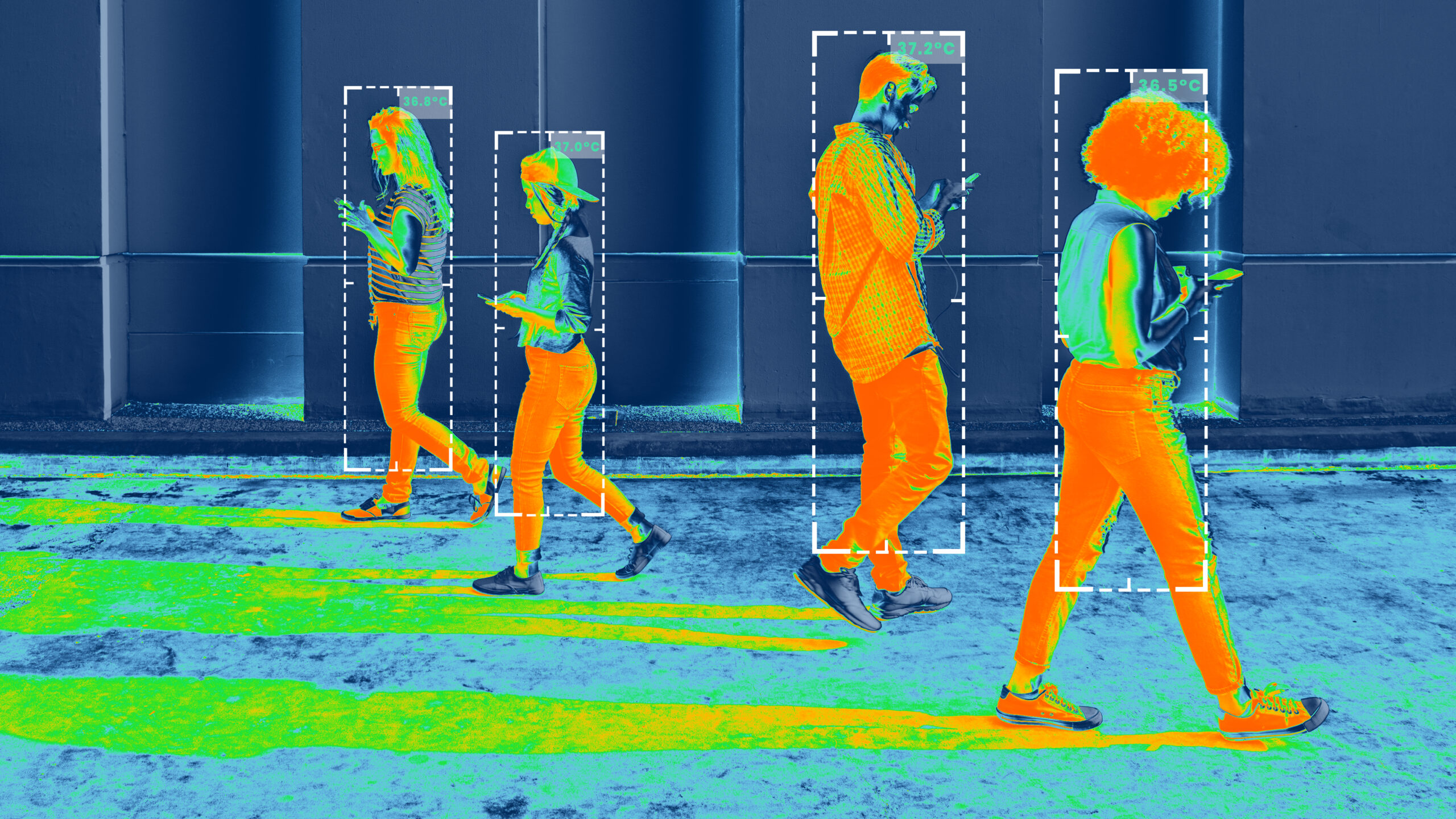Researchers Used AI To Turn Wifi Routers Into ‘Cameras’ That Can See People Through Walls

Right now, in the space around you, there are invisible waves moving through the air—silent, constant, unnoticed. They carry your favorite songs to your speakers, your video calls across oceans, your late-night movies to the screen. WiFi has become so woven into daily life that we barely think about it. We just expect it to be there, working quietly in the background.
But what if those same invisible waves could do more than just connect you to the internet?
What if they could reveal what the eyes cannot see? What if your ordinary WiFi router could detect your presence, your posture, even your movements through walls—without a single camera lens, without you ever noticing?
Researchers at Carnegie Mellon University have shown that this is not a dream of the distant future.
By pairing everyday WiFi signals with deep learning models, they turned simple routers into tools that can “see” people through walls.
A Hidden Power Beyond Connectivity

WiFi is often seen as nothing more than a tool for convenience. It powers our streaming services, supports remote work, and keeps our smart devices connected. Yet beneath its familiar role lies something far more remarkable. WiFi is not simply data moving through the air; it is a constant stream of electromagnetic waves, surrounding us at all times, interacting silently with the world around us.
Every object, every wall, and every person subtly alters these waves. Movements, even the smallest ones, leave behind changes in the signal that most of us never notice. Until recently, those disruptions meant little beyond minor interference. Now, researchers have found a way to interpret them.
At Carnegie Mellon University, a team of scientists realized that by combining WiFi signals with artificial intelligence, they could reveal hidden details about human presence. Using deep learning models, they taught machines to recognize patterns in the way WiFi waves scatter when they encounter a body. What once appeared to be meaningless noise became a detailed map of posture, movement, and presence—even through walls and without the use of cameras.
WiFi, a technology designed to connect us to the digital world, is beginning to connect us to the physical one in ways we never expected. That discovery carries great promise—and demands thoughtful reflection on where we go next.
How Researchers Made It Happen
The idea was simple but powerful. Every time a WiFi signal bounces off a wall, a piece of furniture, or a human body, it changes slightly. Alone, these changes are too subtle for human perception and too random for basic machines to interpret. But artificial intelligence thrives on patterns hidden in complexity.
To unlock these patterns, researchers used deep neural networks—systems designed to learn from large amounts of data. They trained these networks by pairing WiFi signal disturbances with visual information, teaching the AI to associate changes in the signal with human body shapes, movements, and positions. Over time, the models became skilled at detecting the presence of a person, recognizing whether someone was standing, sitting, walking, or lying down, all without ever seeing them directly.
One of the techniques they used, called DensePose, was originally developed to map human bodies in photographs. Adapting it to WiFi signals was a major leap. Instead of using light and cameras, the AI mapped bodies using waves and reflections, creating rough but surprisingly accurate 3D representations of people—through walls, in darkness, and without the need for specialized equipment.
Unlike expensive radar or LiDAR systems, this approach worked with everyday devices: simple WiFi routers already found in millions of homes. That simplicity not only lowered the cost but also made the technology far more accessible. What once required a laboratory or a military-grade system could now, in theory, be achieved with tools already sitting quietly in living rooms and offices around the world.
The foundation was built not on creating something entirely new, but on seeing old technology with new eyes—and trusting that the invisible could be made visible.
Real-World Possibilities

Turning WiFi signals into a tool for sensing human presence opens doors far beyond academic curiosity. It offers practical solutions to everyday problems—solutions that respect privacy while enhancing safety, care, and comfort.
1. Elder Care Without Invasion
Monitoring an older adult’s well-being often comes with a painful trade-off between safety and dignity. Cameras feel invasive. Wearable devices can be uncomfortable or easy to forget. WiFi-based sensing offers a better way. By detecting falls, long periods of inactivity, or unusual patterns of movement, it can alert caregivers to potential problems without constantly recording images or requiring active participation from the person being monitored. It protects without intruding.
2. Smarter and Safer Homes
Traditional motion detectors rely on direct lines of sight or sound triggers. WiFi sensing can detect movement through walls, making it possible to know if someone is in the home even in complete darkness. Unlike security cameras, it does not record faces or collect video footage, offering protection without the risks tied to constant surveillance.
3. Healthcare and Rehabilitation Support
Tracking how someone walks, balances, or sits provides valuable insights during recovery from surgery, injury, or illness. Today, much of this data comes from wearable devices or in-person assessments. WiFi-based sensing could offer the same level of detail without burdening the patient, allowing doctors and therapists to monitor recovery from a distance and intervene when necessary.
4. Smarter Public and Work Spaces
Understanding how spaces are used—whether in offices, airports, or hospitals—can lead to better energy management, improved safety protocols, and more responsive design. WiFi-based systems could track occupancy and movement patterns without forcing individuals to carry tracking devices or manually check in, preserving privacy while making public spaces more efficient.
At its best, this technology offers something rare: a way to create environments that are safer, more responsive, and more compassionate, without asking individuals to sacrifice their sense of freedom or control.
The Two Sides of the Coin: Hope and Concern

Every new technology carries with it a choice. It offers opportunities to build something better, but it also opens the door to unintended consequences. WiFi sensing is no different.
One of its greatest strengths is privacy. Unlike cameras, WiFi-based systems do not capture faces, clothing, or detailed images. They detect presence and motion by reading disturbances in electromagnetic waves. For places where dignity and discretion matter—such as bedrooms, bathrooms, or healthcare facilities—this offers a meaningful alternative to traditional surveillance.
Yet, privacy is never just about what is seen. It is also about what is known. Even without capturing images, WiFi sensing can reveal patterns about where people are, how they move, and how often they engage in certain behaviors. Over time, that information could be pieced together to build detailed profiles of individuals, with or without their consent.
Experts like Dr. Noah Apthorpe, a privacy researcher at Princeton University, have warned that even anonymized location data can be traced back to individuals when combined with other information. In his words, “Location data, even when stripped of identifiers, can often be linked back to individuals.” These concerns apply to WiFi sensing as well. Data that seems harmless on its own can quickly become personal when viewed over time or combined with other sources.
Consent is another critical issue. In private homes, people may welcome the benefits of motion sensing. But in public spaces, workplaces, or shared housing, questions remain. Will people always know when WiFi-based monitoring is active? Will they have a choice to opt out? Transparency and clear communication must be non-negotiable if trust is to be built.
Technology is never just about what it can do. It is about who controls it, who benefits from it, and who is protected—or exposed—by it. WiFi sensing offers real hope for safer, smarter spaces. But without careful, ethical choices, it could just as easily become another way to watch people without their knowledge or consent.
The future of this technology will be shaped not by its technical limits, but by the values we choose to defend as it becomes part of everyday life.
Who’s Watching the Watchers?

Governments and military agencies are no strangers to pushing the limits of technology in the name of security. And with this kind of Wi-Fi sensing, the ability to track individuals through walls without visible tools opens up a new chapter in covert surveillance. Unlike conventional methods, which often require warrants, cameras, or physical access, these systems can be discreetly deployed using existing infrastructure. Imagine law enforcement scanning an entire apartment complex without ever stepping inside—or authoritarian regimes quietly monitoring citizens from across the street.
But the risk doesn’t stop with governments. The fact that this tech can be built using off-the-shelf parts means that anyone with moderate technical skill and a curious (or malicious) streak could build a similar system. Stalkers, hackers, or even nosy neighbors might one day cobble together DIY “x-ray” rigs, capable of peering into your most private spaces using nothing more than signal distortion and a few lines of code.
And let’s not forget about corporations. The same companies that mine our clicks and conversations could someday use Wi-Fi tracking to analyze how we move through our homes, where we linger, or how we sleep—all in the name of product optimization or marketing research. If you thought smart TVs listening to your conversations was bad, just wait until your router starts mapping your bedtime routine.
Not Yet Perfect, But Full of Potential

As powerful as WiFi sensing has already proven to be, the technology is still far from flawless. Much of what researchers have achieved has taken place in carefully controlled environments—labs where variables are minimized, and the system can be finely tuned. Translating that success into the messy reality of everyday homes, offices, and public spaces presents new challenges.
Human bodies come in all shapes, sizes, and movement styles. Environments differ widely: an open office looks nothing like a cluttered living room. Even small changes—like a rearranged piece of furniture or a crowded hallway—can confuse the system. For WiFi sensing to work reliably in the real world, it must learn to adapt to these differences without constant retraining or calibration.
Researchers are already addressing these challenges. One promising approach involves using generative adversarial networks (GANs) to separate meaningful human movement from environmental “noise.” By stripping away irrelevant background signals, the system can focus more precisely on detecting people, even in unfamiliar settings. Early results show that this strategy significantly improves accuracy, bringing practical deployment a step closer.
There is also growing interest in combining WiFi sensing with other low-cost tools like microphones, basic motion sensors, or temperature monitors. Instead of relying on a single source of information, these systems would blend different types of data to create a more complete, reliable picture—without crossing the line into invasive surveillance.
Still, bringing WiFi sensing into everyday products will require more than technical refinement. It will demand public trust. People must believe that these systems serve them, not exploit them. They must feel confident that their privacy is protected, and that they have control over how their information is used.
What We Choose to See

Technology rarely waits for us to be ready. What once sounded like science fiction—WiFi routers detecting people through walls—has already moved from theory into reality. Yet technology by itself does not determine the world we live in. It only amplifies the choices we make.
WiFi sensing offers real benefits. It has the potential to make homes safer, support healthcare, and create more responsive environments without the need for invasive cameras. But these possibilities will only be realized if privacy, transparency, and consent are treated as non-negotiable foundations, not as afterthoughts.
The invisible waves around us now carry more than just information; they carry responsibilities. How we choose to use them will shape the spaces we live in, the trust we build, and the freedoms we protect.
The technology may be unseen, but the impact it leaves will be lasting. In the end, it is not the machine that defines the future—it is the values we choose to stand by.
Featured Image Source: Freepik
Source:
- Wang, F., Zhou, S., Panev, S., Han, J., & Huang, D. (2019). Person-in-WiFi: Fine-Grained person perception using WiFi. 2021 IEEE/CVF International Conference on Computer Vision (ICCV), 5451–5460. https://doi.org/10.1109/iccv.2019.00555
Loading...
Related Content
 When Science Shows Our Bones Can Rise Again
When Science Shows Our Bones Can Rise AgainBy Prince Ea





